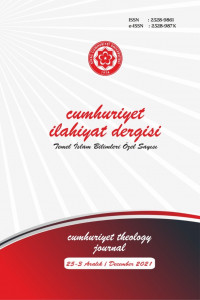Hanefî Usul Düşüncesinin Temellendirilmesinde Sahâbe Uygulamasının Rolü: Serahsî Örneği
The Role of The Practice of The Companions in Establishing The Ḥanafī Uṣūl Thought: Al-Sarakhsī as a Case Study
Author(s): Ahmet Numan ÜnverSubject(s): Islam studies, Philosophy of Religion, History of Islam, Philosophy of Law, Sharia Law
Published by: Cumhuriyet Üniversitesi İlahyat Fakültesi
Keywords: Islamic Law; Islamic Jurisprudence; Ḥanafī School the Companions’ Practice; ʿAmal;
Summary/Abstract: Along with the legal opinions, the juristic proofs presented to underpin these legal opinions also occupy an important place in uṣūl al-fiqh. Thus, scholars of uṣūl al-fiqh strived to propound the proofs indicating the relevant theoretical principles in an apparent and definite way. As a result, the disputed and undisputed proofs ranked among al-adilla al-shar‘iyya have been abundantly addressed in the classical uṣūl al-fiqh works. However, although it is not mentioned as a part of legal sources in the uṣul literature, there has been another proof subjected to legal reasoning (istidlāl): the practice of the companions. In this study, “the practices of the companions” is used in the contextual meaing of the verbal and practical positions of the entire companions or some of them on a specific topic of uṣūl al-fiqh. By this definition, the concept of the practice of the companions is separated from the concepts of qawl alṣaḥābī, ʿamal ahl al-Madīnah and the ijmāʿ al-ṣaḥābah. As a matter of fact, the concept of qawl al-ṣaḥābī signifies an opinion narrated from a single companion and neither supported nor opposed by other companions, and subjected to use of legal inference for obtaining practical legal rulings. In return, the concept of the practice of the companions signifies the position that the companions hold on a topic of uṣūl al-fiqh and does not stipulate the conditions that it must be an opinion of a single companion and be neither supported nor opposed by other companions. In addition, as being related to the legal theoretical issues and not restricted to a certain region, the concept of the practice of the companions is distinct from the ‘amal ahl al-Madīnah. Likewise, it also differed from the ijmāʿ al-ṣaḥābah because the latter concept indicates the consensus of all companions on a practical legal ruling whereas the practice of the companions amounts to both the consensus of the companions and their individual opinions on the matters of uṣūl al-fiqh. Having said that, the concept of the practice of the companions has some overlaps with the qawl al-ṣaḥābī and ijmāʿ al-ṣaḥābah. It is observed in the Hanafi tradition of uṣūl al-fiqh that the practices of the companions are presented as a proof of many principles of uṣūl al-fiqh. This is because of the fact that the companions have a significant role as being the first practitioners of the revelation and the leading figures of the tradition of fiqh. Due to these significant roles of the companions, a central position is given to their interpretation method of the divine text and the technique of issuing legal opinions in determination of theoretical principles. In this study, I examine the impact of the practices of the companions on the Hanafi legal theory focusing on the work of al-Sarakhsī (d. 483/1090), al-Uṣūl, and try to identify how Hanafi legal theory was grounded, departing from, overall or particular, companions’ practices. This study consists of two main parts. First, I provide the conceptual framework by analyzing the concepts of the companion and the companions’ practice. Second, I discussed the theoretical issues rested evidentially on the companions’ practice. Hence, this study excludes the instances of qawl al-ṣaḥābī, ijmāʿ al-ṣaḥābah and the companions’ practice if they are not resorted in proving the uṣūl al-fiqh principles. This work deals with issues on which theoretical principles grounded in reference to the practice of the companions under the headings; Kitāb, Sunnah, qıyās, naskh and alfāz. When instances of the companions’ practice are in abundance in a case, I just focus on the highly representative ones and shortly refer to the others. In the conclusion part, I provide the consequences achieved by this research and some final remarks on the topic.
Journal: Cumhuriyet İlahiyat Dergisi
- Issue Year: 25/2021
- Issue No: 3
- Page Range: 1359-1379
- Page Count: 21
- Language: Turkish

